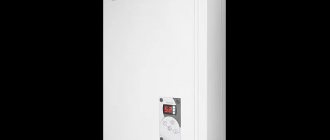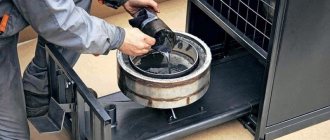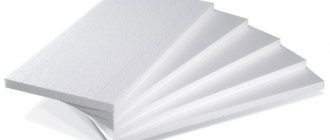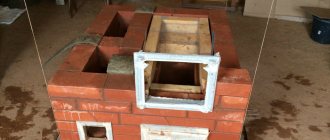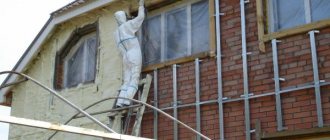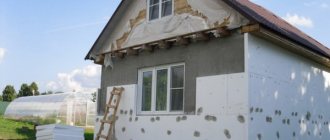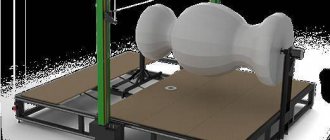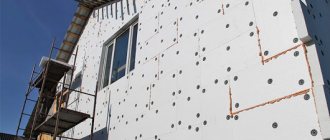Good material can be ruined by inappropriate use. Expanded polystyrene foams are excellent insulation materials. Their heat-saving ability can be impaired by using inappropriate adhesives or solutions to attach them. Manufacturers' recommendations are almost clear. High-quality fastening of the slabs is carried out by specialized foam for polystyrene foam.
Only advantages
Versatility is a good quality. In addition to it, foam for gluing foam has the following advantages.
It creates sealed air volumes under the surface of the expanded polystyrene sheet, increasing the level of thermal protection.
The foam is sold in metal cylinders with threaded connections installed on them.
With their help, the cylinder is connected to the gun.
These two elements ensure a quick start to work and the same change of the used cylinder.
It is necessary to use a special gun to ensure low mixture consumption.
Adhesive for foam plastic consumption:
One cylinder is enough to install 10 -12 m2 of insulation.
It allows you to easily dose and evenly distribute the foam adhesive. To adjust the feed volume, a regulator is installed on the gun. It also ensures that the trigger is fixed in a certain position, preventing excess amounts of the composition from escaping.
The polyurethane foam composition ensures quick fixation of the slabs to the surface. After 2 hours, the next stage of work on fixing the insulation or finishing is allowed.
Its excess can be easily cut off with a construction knife after hardening 30 minutes after application.
An increased degree of adhesion to various materials increases the speed of insulation work. This is the best product for installing foam boards on metal surfaces and smooth concrete.
Its use does not require measures to protect the respiratory organs, eyesight, and skin of the working person. Fire danger is zero.
The foam does not expand after application. This prevents possible distortion of the sheets after installation.
Purpose
This is a composition with a limited scope of application, it is not universal. It was developed for securing slabs made of extruded polystyrene foam. Compatible with standard PPS.
This type of adhesive is used to secure the slab to the bases when installing thermal insulation systems. Some mixtures can be used for all types of work, some of them can only be used for external or internal work. Adhesive foam is used to install thermal insulation of building foundations, roofs, basements, floors, and walls.
Operating procedure
Work is best carried out in calm, warm weather.
To thoroughly adhere polystyrene foam insulation, clean the surface to the material of the insulated surface. Set the starting bar strictly horizontally.
Its width is equal to the thickness of the sheet used. Remove dust by rinsing or sweeping. Prime the wall using a roller or brush. Treat the surface of the foam with a needle roller to improve contact with the adhesive.
Sticking foam is carried out in the following sequence:
- prepare the cylinder for use according to the instructions for use;
- screw the cylinder onto the gun, avoiding distortions;
- apply foam to the treated surface of the slab along the perimeter in a continuous strip about 3 cm high, then in the middle along the long side (the distance from the edge to the layer is at least 20 mm);
- install the stove in its designated place;
- if necessary, adjust its position, checking it using a long building level or rule;
- carry out subsequent stacking of sheets from bottom to top;
- Fill the resulting joints with foam;
- After 30 minutes, cut off the excess that appears with a construction knife.
To adjust the position of the sheet, the same polystyrene foam is used. Use a gun to pierce the foam and pump in the adhesive composition. The leaf retains its relative mobility for 10-20 minutes.
The use of adhesive foam makes installation work as easy as possible. The work can be carried out by one person, both on the surface of the earth and at height.
Preparing the base
Before gluing polystyrene foam boards, it is necessary to carefully prepare the base.
This is a mandatory condition, since the durability of the thermal insulation largely depends on the accuracy and thoroughness of the preparatory work. This allows you to avoid possible situations in which the slabs could come off, destroying the insulation and the facade itself.
If polystyrene foam boards will be attached to the old base, you need to make sure that it is strong. Also, must be clean, dry, free of moss, lichen, etc. If foam is being bonded to new surfaces, remember that any render or concrete must be completely cured and dry.
Sometimes insulation boards can be very smooth. Therefore, it is best to carry out an adhesion test on a small area first. If it is insufficient, the back surface of the polystyrene foam boards must be sanded where the adhesive is applied. This will improve grip.
We use an inexpensive analogue
If there is a lack of funds, you can attach polystyrene foam to polyurethane foam. In order to reduce its consumption, install the insulation using a gun.
When choosing polyurethane foam for penoplex, polystyrene foam and other polystyrene foams, pay attention to its components. It should not contain toluene, alcohols, solvents, or other substances that lead to destruction of the structure.
The procedure for preparing the surface and applying the mixture to the slab does not change. Before gluing the foam, the wall must be moistened with water. Brick and concrete – generously, wooden – lightly.
There are some small peculiarities of fastening penoplex and polystyrene foam with polyurethane foam. They are due to the low speed of gaining the required density. When used in the same manner as adhesive foam, the slabs will need to be held in place for a long time (from 40 minutes to an hour). But this can be avoided.
After applying the composition, apply it to the surface for 3-5 seconds and shake the slab from side to side. Tear it off. Re-apply the mixture to it in a volume equal to half of the required amount. Wet the foam with water from a spray bottle.
Let the process of hardening and gaining density begin. The operating time will take from 2 to 4 minutes (during this time, prepare for the next installation). Then place the plate in place and press it firmly for 10 seconds. You can attach the next one.
This use case will significantly speed up the work process and eliminate the need to use supports and spacers.
Foam adhesive consumption for polystyrene foam
Before work, the technician needs to make sure that the purchased product is enough for the entire scope of repairs. To do this, you need to study the packaging and find information about the consumption, which depends on the weight of the bases being glued.
For example, TechnoNIKOL foam adhesive has a higher concentration of active ingredients: 600 grams in a 750-milliliter container. Therefore, on average, one cylinder will be enough to cover 10 to 12 square meters of surface.
Experts advise making a preliminary calculation of consumption in order to stock up on the required number of cylinders of one brand. Don’t risk buying products from other brands later, because each manufacturer has its own quality of sizing.
Specifications
To understand the functions of the tool, you will need to study its technical characteristics. The basis of the composition is polyurethane, a polymer with increased adhesion.
It is convenient to work with adhesive foam. It is resistant to water and moisture. Economical, sets quickly. Therefore, the insulation of facades takes place in a short time. Such compositions are resistant to temperature changes and have good heat-insulating properties.
Advantages
One package will be enough to treat ten square meters of surface. The master does not need to prepare the composition by stirring the components or diluting it with water. It is already ready for use.
Other benefits:
- After application, the adhesive seam almost does not change its shape and does not expand.
- Applying foam is convenient and easy. It will not be difficult to remove excess material. To do this, use paint solvents or a special cleaner, which is offered by many manufacturers of polyurethane foam.
- Primary setting occurs in 1-2 hours. Complete hardening of the composition will be completed within 24 hours.
- The resulting seams will be strong and reliable.
These factors are the opposite of most other adhesives. They need more time to harden, which leads to an increase in finishing time.
Flaws
Compared to similar products, mounting adhesive foams are sold at higher prices. This composition must be applied with a professional glue gun, which is not included in the kit, so you will need to purchase it separately.
However, not all manufacturers produce products that meet all the declared qualities. Therefore, first we recommend that you study the reviews of specialists about working with products from specific brands on the Internet.
Application technology
In fact, there is nothing complicated in the process of attaching polystyrene foam using special adhesive foam. After all, it was designed to simplify this process.
Adhesive foam is applied to the foam board along the perimeter, with one clear tape
But we will still outline the algorithm of work and take into account several interesting nuances that may affect the result.
It is important to understand that the installation technology does not differ depending on the choice of the adhesive foam itself for attaching polystyrene foam. That is, AKFIX 960 foam will be applied in exactly the same way as Ceresit C-84 adhesive foam.
There are, of course, certain differences, but they relate rather to the technical side of the issue, without affecting the general process.
For example, AKFIX 960 cools faster than Ceresit, and therefore, after application, the slabs will also have to be glued more quickly. But again, even here the difference will be completely insignificant. The point is about differences in a matter of minutes, nothing more.
Stages of work:
- We clean the surface of the polystyrene foam from dirt and dust.
- Clean the base. If the base quickly absorbs moisture, prime it.
- We load the cylinder into the gun.
- Apply foam around the perimeter of the slab.
- Apply another strip of foam in the center of the slab.
- We glue the slab in the right place.
- Let's correct its position.
- We lay the remaining slabs.
- We blow out the joints between them with glue foam.
- Cut off the remaining hardened foam with a knife.
- After 20 minutes you can still trim the slab.
- After 2 hours, the foam has completely cooled and you can begin further processes, for example, drilling dowels or applying the first layer of plaster.
After use, the gun must be washed. Moreover, this is done both mechanically and with the help of special cleaning compounds.
Let us remind you that you can buy polystyrene foam in Orel at a favorable price.
Mechanical cleaning consists of cutting off excess foam from the supply tube, and chemical cleaning is carried out using cylinders with cleaning liquid. They are connected to the gun and the barrel of the instrument is pumped at maximum pressure until it completely leaks.
2.1 Selection of adhesive foam for polystyrene foam (video)
What are the advantages of using foam in the case of penoplex?
Penoplex is used as a soundproofing material, and polyurethane foam is used to blow in the seams between the plates. At the same time, it qualitatively seals the seam. Another useful function offered by foam is gluing the foam board to surfaces, even vertical ones.
Even an inexperienced builder can do this kind of work. The slabs are glued unnoticed, however, the penoplex is securely fixed and they proceed to the next stage.
Application of foam with penoplex
Using this product instead of glue will help save money, applying the foam is much easier and requires less time to dry completely than glue. The use of foam is in no way inferior to specialized glue in terms of adhesive properties. Why do they buy it to simultaneously use it both for gluing penoplex and for blowing in seams and joints.
Basic rules for attaching foam plastic
High-quality fastening of polystyrene foam to the wall is the basis for insulating a house. During installation, the main thing is that the material fits tightly to the working surface. It is impossible for air to circulate between the thermal insulation and the wall, otherwise the entire insulation effect is reduced to zero. When air blows over the wall, it takes with it all the heat that has passed through the enclosing structure. At the same time, polystyrene foam does not save the situation in any way - it just hangs on the wall.
In theory, all the heat that passed through the wall upon contact with the insulation stops moving, since the thermal conductivity of the foam is very low (0.034 W/m*K). In this case, the wall begins to accumulate heat and release it back into the room. But as soon as you allow the insulation to adhere loosely to the wall, the whole scheme collapses before your eyes. This is why preparation of the work surface is also important. The smoother the wall, the less likely it is that ventilated air gaps will remain under the foam. Particular attention should be paid to the bottom and side ends of the insulation cake.
Bulk insulation vermiculite can be used for thermal insulation of walls, but for this certain conditions must be met.
But, for example, adhesive-based insulation is not used for these purposes at all.
When insulating a house with mineral wool using the wet facade method, a base profile is used. It supports the mineral wool sheets and also blocks the path of air. For polystyrene foam, a base profile is not necessary, since this material is lightweight. It is enough to properly seal the bottom edge. To attach foam to the wall use:
- universal dry construction mixtures;
- glue foam;
- dowels fungi.
Before attaching foam plastic, familiarize yourself with the technology according to which you need to combine several fastening options.
Mushroom dowels for fastening foam plastic
Fungi for attaching foam plastic are used only in conjunction with glue. Without it, there will be a gap under the thermal insulation through which air will circulate (similar to the principle of a ventilated facade). We have already talked about the consequences.
To secure the insulation sheets, a hole is drilled through them using a hammer drill. Then a dowel is driven into them. The fungus cap securely holds the foam. One sheet requires five dowels. To find out more about this type of fastener, read our article “Mushroom dowels”.
Application technique
TechnoNIKOL foam adhesive and other brands of such compounds must be used in strict compliance with the manufacturer’s instructions. To work correctly with such tools, they follow the following algorithm:
- pre-clean the surface from dirt and grease;
- put a nozzle gun on the glue bottle;
- foam adhesive for polystyrene foam is applied evenly (try to maintain the thinness of the layer required for gluing);
- then the glued part is placed on the surface with the material and pressed with force to secure it;
- the processed parts are left to harden for the time specified in the manufacturer’s instructions;
- It will take at least 1.5-2 days for the adhesive foam to completely harden.
